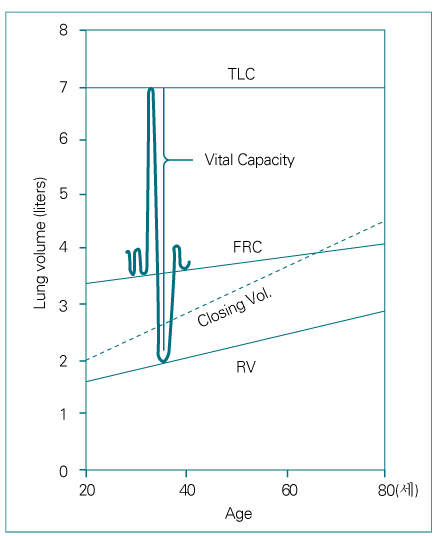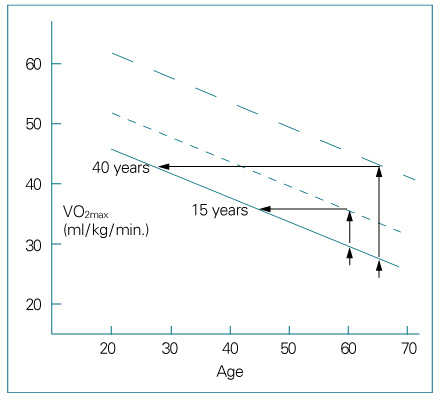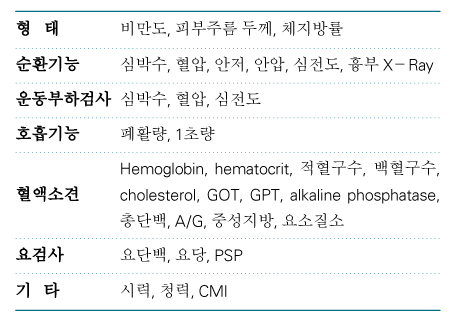 |
 |
- Search
| J Korean Med Assoc > Volume 48(9); 2005 > Article |
Abstract
The health benefits from exercise, particularly in a sedentary society, have gained a compelling body of evidence in the past decade. Younger adults have a considerably bigger physiologic reserve, both in terms of muscular strength and cardiovascular capacity. The elderly, on the other hand, experience a progressive decline in many physiologic functions, including muscular strength and cardiovascular capacity. Habitual exercise, by improving strength and maximum aerobic capacity (VO2max), can increase the physiologic reserve as well as enhance well-being by reducing fatigue associated with activities of daily living. Mostly importantly, it can delay the development of disability and thereby prolong active life expectancy. In addition to habitual exercise for conditioning, there is increasing evidence that resistance exercise to improve muscle strength along with tailored exercise therapies, including those designed to improve balance or to rehabilitate persons with various chronic diseases and acute ailments, may be of special value for the elderly. There is growing evidence that exercise programs offer measurable health benefits, ranging from increased life expectancy to mitigation of adverse sequelae from aging and from many chronic diseases. The greatest challenges in achieving health benefits from exercise are the limited access to effective programs and poor compliance.
References
5. Abrass IB. The biology and physiology of aging. West L Med 1990;153:641-645.
6. Braddom RA. In: Felsenthal G, Stein BD, editor. Principles of geriatric rehabilitation. Physical medicine & rehabilitation 1996;Philadelphia: WB Saunders. 1242.
7. Cassel CK, Leipzig RM, Cohen HJ, Larson EB, Meier DE. In: Larson EB, Bruce RA, editor. Exercis. Geriatric medicine 2003;4th ed. New York: Springer-Verlag. 1023-1029.
8. Delisa JA. In: Clark GS, Siebens HC, editor. Rehabilitation of the geriatric patient. Rehabilitation medicine. Principles and Practice 1993;2nd ed. Philadelphia: Lippincott. 642-665.
9. Kawas CH. In: Felsenthal G, Garrison SJ, Steinberg FU, editor. Evaluation of cognition in the elderly rehabilitation patient. Rehabilitation of Aging and Elderly Patient 1994;Baltimore: Williams & Wilkins. 215-226.
10. Geokas MC, Lakatta EG, Makinodan T, Timiras PS. The aging process. Ann Intern Med 1990;113:455-466.
11. Larson EB, Bruce RA. Health benefits of exercise in aging society. Arch Intern Med 1987;147:353-356.
12. Mosby's medical, nursing, and allied health dictionary 1994;4th ed. St. Louis: Mosby. 583-584.
13. Naughton J. Physical activity and aging. Prime care 1982;9:231-238.
14. Poster JD, Gorman KM, Klein HS, Woldow A. Exercise capacity in the elderly. Am J Cardiol 1986;57:52C-58C.
15. Stern N, Tuck ML. Geriatric cardiology: Homeostatic fragility in the elderly. Cardiol Clin 1986;4:201-211.
- TOOLS
-
METRICS

-
- 0 Crossref
- Scopus
- 1,030 View
- 4 Download
-
Related articles in
J Korean Med Assoc -
Emergency Care in Orthopaedic Surgery1999 May;42(5)
How to Promote Health in the Elderly2001 August;44(8)
Renal Disease in the Elderly2004 March;47(3)








